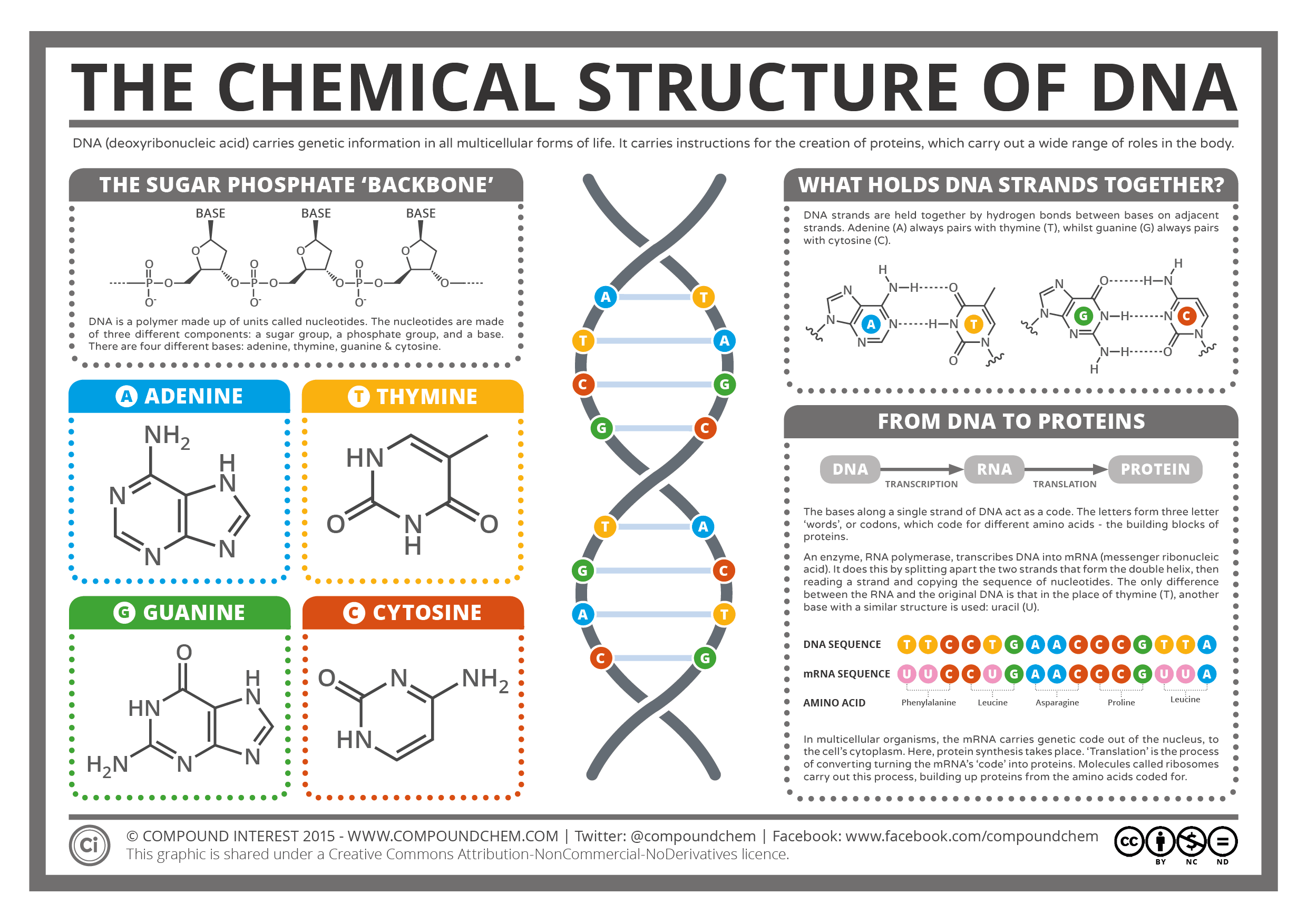Chakra_Khan
Member
I had all this in my mind around October of '15, fresh off the release date of TPP (and back when I frequented the mgs related threads like a madman). I'd also continued to analyse and embellish the ideas I had rolling around in my skull in the wake of this game here and there throughout the craziness that was 2016. I'm finally getting around to this now because a.) I finally got my hands on a compooter and b.) I'd like to finally externalize this before anymore time goes by.
I realize the feelings that TPP left most of us with, and they were quite bittersweet.......actually just bitter and cold. In the aftermath, we all expressed our disappointment with this behemoth and the potential that it held. I hold this game in the same regard as The Dark Knight Rises: all the elements were present, its just the execution that didn't pan out so well (in my opinion). But in lieu of that, I wanted to submit this.......let's call it a psuedo-analysis of sorts, to the scrutiny of the community because despite all the reviews and critiques and analysis' of this game (and I've seen A LOT of em) , not a SINGLE one fully embellishes the idea that The Phantom Pain is an inversion of The Sons of Liberty. I'm not just referring to the "twist" when I say this either. I mean to say that the overall sequence of events, the plot, the structure, etc. betwixt the two games are mirror images of one another.
Before I begin, I'd like to preface with links to a few sources that aided in my thinking process regarding Kojima's work on the metal gear series.
http://www.deltaheadtranslation.com/index/
http://https://www.youtube.com/watch?v=T-2YuPGYabw
I'm quite sure most of the metal gear community is familiar with the aforementioned, but for anyone who isn't, I would recommend at least reading the delta head translation links as they provide clarity on how Kojima re-uses elements from games prior.
"Charade's usually are humorous" - Ocelot, MGS 2
SUBVERTING THE SUBVERSION OF EXPECTATION
First I'd like to start with an image:

It is the cover art of David Bowie's 1977 LP "Heroes", which was done by Japanese photographer Masayoshi Sukita. The inspiration of which came from the paintings of the painter Erich Heckel. I'd like to follow up this image with another:
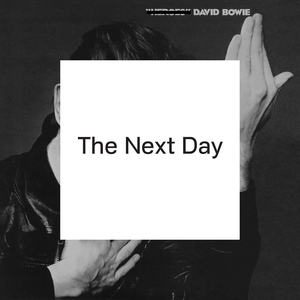
This is the cover of Bowie's 2013 LP "The Next Day". The following is a snippet of information regarding the cover art from the album's wikipedia page:
" The cover art for the album is an adapted version of Bowie's 1977 album, "Heroes", with a white square with the album's title obscuring Bowie's face.[29] Designed by Jonathan Barnbrook, who also designed packaging for Heathen and Reality, the obscuring of the photograph connotes "forgetting or obliterating the past".[30][31] The original cover image was shot by Masayoshi Sukita.[32] Barnbrook explained the cover, saying: "If you are going to subvert an album by David Bowie there are many to choose from but this is one of his most revered, it had to be an image that would really jar if it were subverted in some way and we thought "Heroes" worked best on all counts."[33] A viral marketing campaign was launched to promote the album on 15 February 2013. The campaign grew out of the concept behind the album cover, taking seemingly ordinary images and subverting them through the addition of a white square.[34] ".
If David Bowie's "Heroes" is Metal Gear Solid 2, then I would infer that "The Next Day" is Metal Gear Solid V.
As I continued to marinate on the game after completion, I kept pondering why Kojima was using an artist as prolific and off kilter as Bowie as a motif of sorts with something like Metal Gear of all things. It was then almost immediately that the image of "The Next Day" came into my mind and that's when my perspective on the game was augmented. Initially, my thinking was that Kojima was using this idea a mantra of sorts through the development of V, but this is a fallacy as the phantom pain marketing campaign debuted in December of 2012 whereas the marketing campaign for the Bowie record began in February of 2013 as mentioned above. Regardless, I fervently believe that Kojima had to have been inspired by this in some capacity or another. Lets also keep in mind that George Weidman's highly lauded Critical Closeup of MGS 2 launched on youtube June 4 of 2013. I'm on the fence about coincidences, but something was definitely in the air during this year.
Let us now look at the narrative and aesthetic association between the 2 games and defer from taking things at face value, pun intended, as we also examine how the forms are inverted and fragmented among multiple characters/scenarios.
The Prologue (Ground Zeroes and the Tanker Chapter)

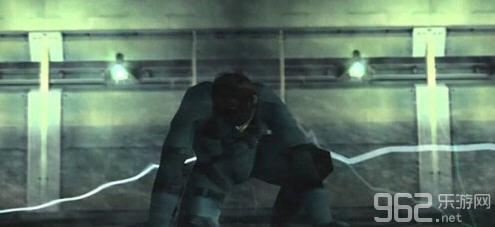
- Snake infiltrates an american facility with an agenda hidden from the public under the cover of a dark and stormy night accentuated through the lense of an atmospheric, blue camera filter.
- Instead of descending to the sneak point via bungee cord, he ascends via rock face. This association between between the infiltration's of SS and BB are affirmed when the camera zooms in on BB's visage which pays homage to SS's in MGS 1's menu screen (the Deja Vu mission makes this painfully obvious and perhaps takes those associations even further within the mission itself) whilst also alluding to SS's infiltration in the very first Metal Gear.
- Unbeknownst to Snake, the facility is also infiltrated by a third party: a militant force led by a man with a cowboy fetish and an air of flamboyant theatricality. In GZ, they've infiltrated the location well before Snake has, as the game actually opens up on them.
- Snake ultimately accomplishes his objective(s) but it turns out to be a ruse orchestrated by the villain in order to flush the protagonist out in the open. Only the villain isn't even present when the shit hits the fan ( Skullface/Ocelot).
- In the end, the villain destroys the evidence (notice the first "big shell" (peace walker's mother base) is actually brought down by C4 this time.), seemingly kills snake (leaving him to the bosom of the ocean) and makes off with the superweapon (Zeke/Ray). The latter portion being implied off screen instead of playing out before the players eyes.
- After the damage is done, the prologue is capped off by a conversation between the villain and a conspirator who know more than the player does: Ocelot and Solidus/ Skullface and Paz.
Main Game (The Phantom Pain and the Plant Chapter)

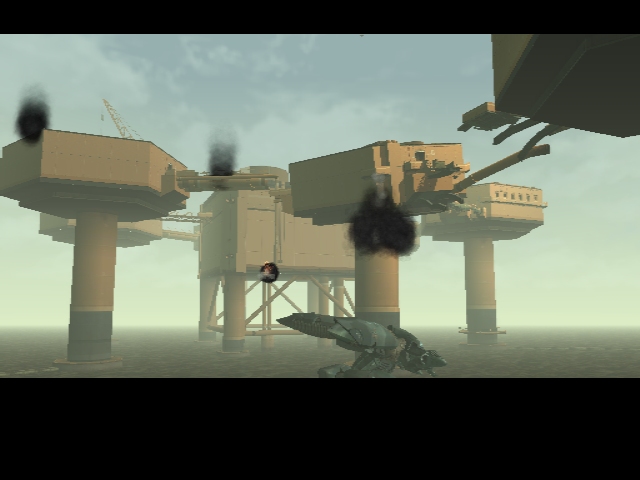
- We start the game off a few years later (with an opening quote no less) as "Snake" with a clearly mistaken sense of identity.
-The opening funnels players through a linear sequence which essentially teaches them how the game is played. As SuperBunnyHop once pointed out, this is strange to think about when you consider that the prologue (gz/tanker) already introduced us to the dynamics and features the game had to offer (albeit a few new ones here and there).
- Much like the opening of the plant chapter, the player wouldn't have survived the path to the elevator had they not been following in the footsteps of the real Snake. Unfortunately, in TPP, the elevator is destroyed entirely.
- When we meet the real Snake, he is a masked man who goes by a pseudonym (Pliskin/Ishmael) and has a particular skillset in combat and avoiding detection. He gives us a pistol for protection and offers advice on how to survive in the field. As opposed to learning his real identity midway through the game (mgs2), we are revealed the truth at the very end (mgsv).
- A Side Note: Interestingly, notice how, at the end of the opening sequence of V, a tanker makes a brief appearance and, what do you know, it is occupied by a Snake and an Ocelot; the former of which has a fake arm grafted on and a personality disorder. See the inversion of 2's narrative? I feel that this is a sly nod between the two games on Kojima's part and perhaps alludes to the transition from one chapter to the next. From the ship, to the plant.
- Aside from the two main open world locations (which I'd say hearken back to mgs4(middle east) and mgs 3(jungle setting)), the meat of the story takes place on an orange hued rig in the middle of the ocean, that was originally intended for research but is now occupied by a mercenary force led by a one eyed man and a cowboy. However, this plant which the actors occupy is nothing more than a fabrication; an elaborate stage.
Let's look at the "players on the stage" in each game and see how the cast compares/contrasts with one another:
- Aside from the optional bulky armor (and being a one eyed copy of Big Boss), there are other aesthetic clues on Venom's person which allude to Solidus (I'm aware this seems like a stretch, but humor me)
- There is a support team consisting of two people who are playing fake roles to ensure the player reaches their goal.
- The role of the love interest who may or may not exist (Rosemary) is divided between Paz and Quiet:
- Comparatively, Paz and Emma Emmerich both serve to make the player's character feel guilty over not being able to save them. Notice the stomach wound the two share.
- While in stark contrast to Rosemary, Paz's uterus carried death instead of life.
- Quite may also share attributes similar to Fortune (as the vengeance seeking, scantilly clad female soldier who cannot die) and Vamp (as the scantily clad, superhuman who's powers are dependent on water(as folks once theorized of Vamp before mgs4))
- There is a scientist, an Emmerich (Huey/Hal), who unleashes a virus (biological V/ digital 2) on the mercenary group wreaking all kinds of havoc. He eventually escapes the rig (boat V/chopper 2) but not unscathed due to the loss of his lover (and child in V).
- Strangelove fills the role of Olga, a white haired woman forced, against her will, to do the bidding of an evil organization because they abducted her child.
- The antagonist, Skullface, is a ruthlessly idealistic copy of a villain(Solidus/Big Boss/Venom's phantom) who's gone rogue from the organization which made him and has the sympathetic goal of ridding the world of their absolute control but is ultimately thwarted by the player:
- Speaking of Raiden vs Solidus, Eli's role mirrors that of Raiden's as the blonde haired, blue eyed leader of a group of child soldiers from Africa. Being "made" in the likeness of Snake, both Eli (The White Mamba) and Jack (The White Devil) "fight to sever the ties that bound them to him", to appropriately quote Solidus. However, Eli fully accepts and relishes his role as the copy of a killer whereas Raiden reluctantly fulfills his role in order to reclaim his identity (similar to Venom's arc). This association is strongly hinted at upon the players first confrontation with Eli: a bladed, one on one duel amid the wreckage of a ship run aground (Federal Hall/Masa Village). In this way, one might argue that the gene vs meme plot point is dynamically inverted:
- Eli or Liquid Snake's arc comes to an end with a moment of foreshadowing, as he, with the aid of a supernatural force, makes off with the super weapon(Sahelanthropus/Metal Gear Ray) towards the game's end(V above the water, 2 below the water), leaving a loose end or cliffhanger. This is why I don't have a problem with Chapter 3 being a no show.
- The Skulls obviously fill the role of the Arsenal Tengu's. The advanced suits, the automatic weapons, and the swords are all there except the Skulls in V are bullet sponges as opposed to the Tengu's in 2, who are easily killable mooks.
(I don't have much regarding the machines in the game (V) but here are my thoughts):
- Battle Gear is created as a deterrent against the Walker Gears but is ultimately cast aside as Arsenal Gear, similarly, was.....or will be(y'know cuz the timeline. metal gear historicity is fecked man)
- the Walker Gears, in that instance, may very well be a precursor to the mass produced metal gears that were the result of leaked black market plans, a la ocelot, in 2.
- This may be a plot hole considering the debriefing in the truth tapes (wherein Ocelot informs us that Anderson is basically overseeing the A.I. network), BUT, if I'm not mistaken, AL, TJ, JD, and GW were all pooled into the main A.I. (The Boss) pod that shows up in TPP. If that's the case, then that means that the A.I. has been on motherbase, analyzing the data of the situation its been in, the players involved, the outcomes and refuse from the exercise and then will eventually use such as the blueprint for what will ultimately become the S3 plan in SOL maaaany years later.
Let's examine the "stage" itself
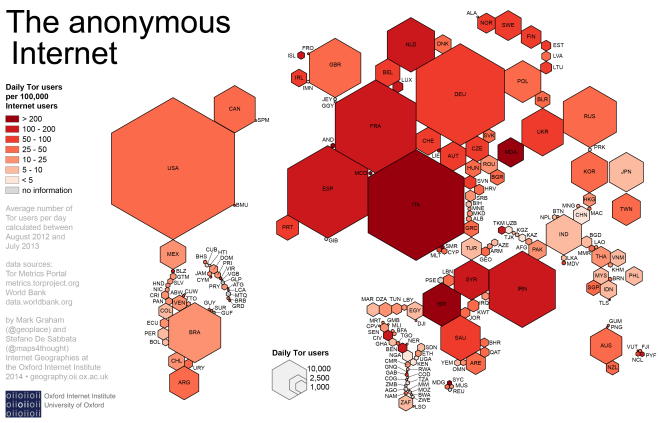
The above imagine is called a Cartogram, and this particular one was made to express Tor usage worldwide. The reason I'm using this image isn't solely to pander to Metal Gears prophetic theme of information control nor is it because of my love for the geometric perfection that is the hexagon. It is also because it connotes to my feelings regarding the series using the hexagon as a motif; ESPECIALLY in TPP and SOL.
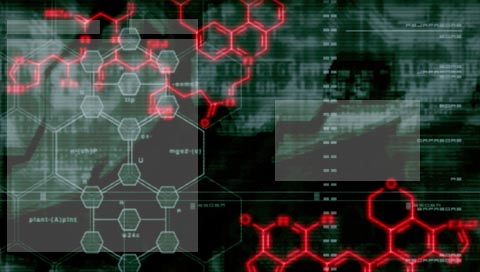
The Stage in Sons of Liberty
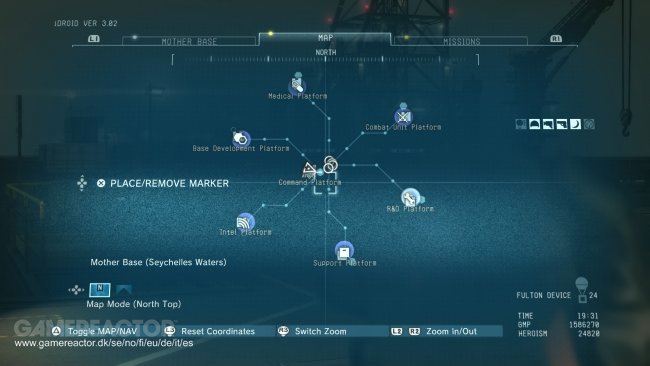
The Stage in The Phantom Pain
The parallel form of the big shell stands in stark contrast to the crooked, yet symmetrical geometry of the seychelles waters' mother base in '84. Notice the uniform, almost atomic structure like pattern the two share, yet in contrast, the seychelles base looks more akin to a virus or, more appropriately, a parasite. The fake stage in V is, itself, corrupted. Figuratively speaking, the Big Shell is a cartogram of sorts. A cartogram of self deception. As is motherbase. Only, within the gameplay driven narrative of TPP we enforce the deception by building the "stage" ourselves. How does the stage get built? Kaz answers this beautifully in one of the cassette tapes: "....So our only option is to fight, and grow, and fight, and grow."
Simulation and Simulacra
To come full circle, Kojima uses a licensed piece of music in the form of Midge Ure's 1982 version of the Bowie classic "The Man Who Sold the World" in the opening moments of the phantom pain. This is, in part, an allusion to the illusion of the entirety of the game's plot. The song is the phantom of the original. Mgs V is the phantom of Mgs 2; a meme of a meme, a twist of a twist, a contradiction of a contradiction. It is the inverted mirror image of the game which, 14 years prior, consistently denied player catharsis. V does not deny us catharsis. No, it kills it, using words.


Both games conclude similarly; with the real Snake revealing to us the ultimate truth about the narrative and what it all meant. Kojima himself stated once, that he wants each of his games to carry with it a message about the world, and to convey (in his own way) that to the player while making them a part of it. In keeping with the thesis of this shitty analysis, it is at this point which I humbly infer that my conclusion of this games "attempted" message differs from most others. To clarify, I've seen that most people feel that the message directed to the players is one of meta-clairvoyance and positivity(similar to MGS 2); that Kojima was playfully thanking the fanbase for being a part of the series' wayward and storied history all this time. I defer, by saying there is a layer of sinister manipulation illicit'ed through the cassette tapes of TPP, and this leads me to my point: Snake, the real one, isn't even present for the players ultimate revelation.
If we can accept that, in mgs 2, Snake is an analog for Kojima telling us to be our own man and that we're, to quote Big Boss in 4, "free to be outside", then we can infer that ,in mgs v, Kojima (Snake) indirectly tells us we're free to be him (Snake) and thus takes the keys (to metal gear) and rides off into the sunset; closing the loop on the saga by leaving it on the same note he intended to way back in 2001: by leaving us trapped within it. The loop, in this instance, conjures the image of an ourobouros; a serpent eating its own tail.

This was the backdrop used for the pause screen when we did naked cartwheels in Arsenal
The image is used to resemble infinity, or, an endeavor without end. Much like outer heaven. In a sense, we never left Arsenal Gear. In this story, Ahab(Kojima/BigBoss) switched with Ishmael(Venom/Player), and left him in the belly of the beast; forever cursed to be ingested, digested, defecated out, and re-ingested in an endless cycle of fighting, and growing, and fighting, and growing. I'll elaborate on this idea further with two very telling clues:
Firstly, Consider the tantalizing reveal trailers for both games.
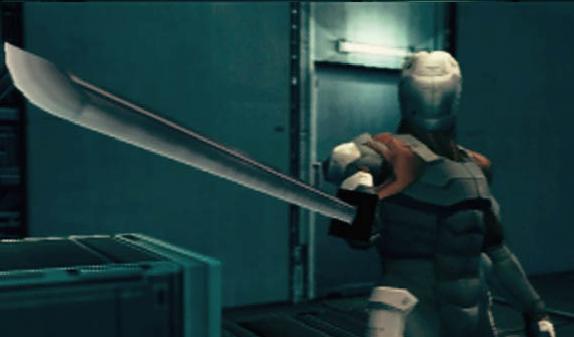

mgs 2 reveal trailer and final game


The GDC '13 reveal trailer and final game
Back during the development of mgs 2, Kojima kept his elaborate ruse hidden by doctoring in Snake for scenes where Raiden(the analog for the player) would normally be, such as the infamous cyborg ninja encounter in the images above. Kojima inverted the form this time around by hiding Venom(the analog for the player) in plain site at the end of the GDC 2013 trailer. The beginning and the ending of the game were already revealed to us. Now with regard to the ending of the game:
Consider Eva and Big Boss.


The notion of Kojima's intent is also implied by the similarity of the departure of the characters, Eva and Big Boss, at the end of each game (V and 3). Snake is wearing a similar riding getup to that of Eva. The leather the jacket, the goggles, the Triumph motorcycle.....it's all there. Even Snakes riding pants have the same tan hue that Eva's jumpsuit has. Both characters fuck us over (in Eva's case quite literally), debrief us with an audio recording, and ride off with the goods. Implying that Kojima mindfucked us by NOT mindfucking us and taking off with his own "Philosopher's Legacy": the legacy of the narrative of the entire saga.
Among the all the vitriol and dissatisfaction exuded from these forums in the wake of the backlash regarding the final package ( I was there), there was one commenter who's disgust with the game was such that he was expressed something that caught my eye: that the story was so inconsequential, that it tarnished his ability to enjoy the series as a whole. Though I have my issues with the game myself, and though most of us could scoff at the way the game ultimately handled the theme of vengeance, I can't help but wonder if this was the goal. That this was the Phantom Pain: Kojima's vengeance on the fanbase for not heeding his warning about the dangers of meme's the first time. We asked for answers, and we got them. We asked for less cutscenes, and we got the tapes. We asked for better gameplay, and we got it. We were left wanting in a "world without borders".
Many argued that the theme's of this game were either minimal at best or non existent at all. I would argue that the theme's of the entire saga: genes, memes, scenes, sense, race, and revenge, are all there. Yes, all of them. Except for..........

Boom.
Thus, the inversion of MGS 2's message subsequently renders the narrative and form of MGS V obsolete. In this backwards world, medicine ( the Medic) turns into poison (Venom).
Reflection
That about wraps her up. There are a lot more examples of association between the games out there I'm sure. As for the characters left out, I honestly had no ideas concerning the roles of Volgin (how we go from lighting to fire is just tacky) The third boy (why is he the third Kojima?)and Codetalker( though if I had any thoughts on him it'd be that his real name is George and his Wolbachia does the trick of both healing the infected whilst rendering them infertile(Venom/Solidus+Exxons/Introns). Thus it is George's Wolbachia or GW that fixes the virus problem in V.)
I've wanted to post this for a loooooooooong time now. And wouldn't you know it, it's my first thread. Thank you for taking the time to read it if you have. I hope it gave you some food for thought. It definitely made me harbor jaded feelings toward The Force Awakens that's for sure. Please, please, please, leave your thoughts and ideas. Very much would love to hear them.
Toodles.
BONUS
Do you know how many months went by between the release of The Phantom Pain and David Bowie's death?

I realize the feelings that TPP left most of us with, and they were quite bittersweet.......actually just bitter and cold. In the aftermath, we all expressed our disappointment with this behemoth and the potential that it held. I hold this game in the same regard as The Dark Knight Rises: all the elements were present, its just the execution that didn't pan out so well (in my opinion). But in lieu of that, I wanted to submit this.......let's call it a psuedo-analysis of sorts, to the scrutiny of the community because despite all the reviews and critiques and analysis' of this game (and I've seen A LOT of em) , not a SINGLE one fully embellishes the idea that The Phantom Pain is an inversion of The Sons of Liberty. I'm not just referring to the "twist" when I say this either. I mean to say that the overall sequence of events, the plot, the structure, etc. betwixt the two games are mirror images of one another.
Before I begin, I'd like to preface with links to a few sources that aided in my thinking process regarding Kojima's work on the metal gear series.
http://www.deltaheadtranslation.com/index/
http://https://www.youtube.com/watch?v=T-2YuPGYabw
I'm quite sure most of the metal gear community is familiar with the aforementioned, but for anyone who isn't, I would recommend at least reading the delta head translation links as they provide clarity on how Kojima re-uses elements from games prior.
"Charade's usually are humorous" - Ocelot, MGS 2
SUBVERTING THE SUBVERSION OF EXPECTATION
First I'd like to start with an image:

It is the cover art of David Bowie's 1977 LP "Heroes", which was done by Japanese photographer Masayoshi Sukita. The inspiration of which came from the paintings of the painter Erich Heckel. I'd like to follow up this image with another:

This is the cover of Bowie's 2013 LP "The Next Day". The following is a snippet of information regarding the cover art from the album's wikipedia page:
" The cover art for the album is an adapted version of Bowie's 1977 album, "Heroes", with a white square with the album's title obscuring Bowie's face.[29] Designed by Jonathan Barnbrook, who also designed packaging for Heathen and Reality, the obscuring of the photograph connotes "forgetting or obliterating the past".[30][31] The original cover image was shot by Masayoshi Sukita.[32] Barnbrook explained the cover, saying: "If you are going to subvert an album by David Bowie there are many to choose from but this is one of his most revered, it had to be an image that would really jar if it were subverted in some way and we thought "Heroes" worked best on all counts."[33] A viral marketing campaign was launched to promote the album on 15 February 2013. The campaign grew out of the concept behind the album cover, taking seemingly ordinary images and subverting them through the addition of a white square.[34] ".
If David Bowie's "Heroes" is Metal Gear Solid 2, then I would infer that "The Next Day" is Metal Gear Solid V.
As I continued to marinate on the game after completion, I kept pondering why Kojima was using an artist as prolific and off kilter as Bowie as a motif of sorts with something like Metal Gear of all things. It was then almost immediately that the image of "The Next Day" came into my mind and that's when my perspective on the game was augmented. Initially, my thinking was that Kojima was using this idea a mantra of sorts through the development of V, but this is a fallacy as the phantom pain marketing campaign debuted in December of 2012 whereas the marketing campaign for the Bowie record began in February of 2013 as mentioned above. Regardless, I fervently believe that Kojima had to have been inspired by this in some capacity or another. Lets also keep in mind that George Weidman's highly lauded Critical Closeup of MGS 2 launched on youtube June 4 of 2013. I'm on the fence about coincidences, but something was definitely in the air during this year.
Let us now look at the narrative and aesthetic association between the 2 games and defer from taking things at face value, pun intended, as we also examine how the forms are inverted and fragmented among multiple characters/scenarios.
The Prologue (Ground Zeroes and the Tanker Chapter)


- Snake infiltrates an american facility with an agenda hidden from the public under the cover of a dark and stormy night accentuated through the lense of an atmospheric, blue camera filter.
- Instead of descending to the sneak point via bungee cord, he ascends via rock face. This association between between the infiltration's of SS and BB are affirmed when the camera zooms in on BB's visage which pays homage to SS's in MGS 1's menu screen (the Deja Vu mission makes this painfully obvious and perhaps takes those associations even further within the mission itself) whilst also alluding to SS's infiltration in the very first Metal Gear.
- Unbeknownst to Snake, the facility is also infiltrated by a third party: a militant force led by a man with a cowboy fetish and an air of flamboyant theatricality. In GZ, they've infiltrated the location well before Snake has, as the game actually opens up on them.
- Snake ultimately accomplishes his objective(s) but it turns out to be a ruse orchestrated by the villain in order to flush the protagonist out in the open. Only the villain isn't even present when the shit hits the fan ( Skullface/Ocelot).
- In the end, the villain destroys the evidence (notice the first "big shell" (peace walker's mother base) is actually brought down by C4 this time.), seemingly kills snake (leaving him to the bosom of the ocean) and makes off with the superweapon (Zeke/Ray). The latter portion being implied off screen instead of playing out before the players eyes.
- After the damage is done, the prologue is capped off by a conversation between the villain and a conspirator who know more than the player does: Ocelot and Solidus/ Skullface and Paz.
Main Game (The Phantom Pain and the Plant Chapter)


- We start the game off a few years later (with an opening quote no less) as "Snake" with a clearly mistaken sense of identity.
-The opening funnels players through a linear sequence which essentially teaches them how the game is played. As SuperBunnyHop once pointed out, this is strange to think about when you consider that the prologue (gz/tanker) already introduced us to the dynamics and features the game had to offer (albeit a few new ones here and there).
- Much like the opening of the plant chapter, the player wouldn't have survived the path to the elevator had they not been following in the footsteps of the real Snake. Unfortunately, in TPP, the elevator is destroyed entirely.
- When we meet the real Snake, he is a masked man who goes by a pseudonym (Pliskin/Ishmael) and has a particular skillset in combat and avoiding detection. He gives us a pistol for protection and offers advice on how to survive in the field. As opposed to learning his real identity midway through the game (mgs2), we are revealed the truth at the very end (mgsv).
- A Side Note: Interestingly, notice how, at the end of the opening sequence of V, a tanker makes a brief appearance and, what do you know, it is occupied by a Snake and an Ocelot; the former of which has a fake arm grafted on and a personality disorder. See the inversion of 2's narrative? I feel that this is a sly nod between the two games on Kojima's part and perhaps alludes to the transition from one chapter to the next. From the ship, to the plant.
- Aside from the two main open world locations (which I'd say hearken back to mgs4(middle east) and mgs 3(jungle setting)), the meat of the story takes place on an orange hued rig in the middle of the ocean, that was originally intended for research but is now occupied by a mercenary force led by a one eyed man and a cowboy. However, this plant which the actors occupy is nothing more than a fabrication; an elaborate stage.
Let's look at the "players on the stage" in each game and see how the cast compares/contrasts with one another:
- Aside from the optional bulky armor (and being a one eyed copy of Big Boss), there are other aesthetic clues on Venom's person which allude to Solidus (I'm aware this seems like a stretch, but humor me)
- A primary and seconday weapon carried on the hip (katana/wakasashi)
- A third weapon slot ( Solidus' MP90)
- A back mounted weapon (missle firing tentacles)
- There is a support team consisting of two people who are playing fake roles to ensure the player reaches their goal.
- Kaz/Campbell (notice Kaz's colonel like aesthetic)
- Ocelot/Rosemary (notice Ocelot's desire to bone?)
- The role of the love interest who may or may not exist (Rosemary) is divided between Paz and Quiet:
- Paz in the sense that she doesn't exist (A.I. Rosemary)
- Quiet in the sense that she does exist only instead of being there at the end of the game, she is nowhere to be found
- Comparatively, Paz and Emma Emmerich both serve to make the player's character feel guilty over not being able to save them. Notice the stomach wound the two share.
- While in stark contrast to Rosemary, Paz's uterus carried death instead of life.
- Quite may also share attributes similar to Fortune (as the vengeance seeking, scantilly clad female soldier who cannot die) and Vamp (as the scantily clad, superhuman who's powers are dependent on water(as folks once theorized of Vamp before mgs4))
- There is a scientist, an Emmerich (Huey/Hal), who unleashes a virus (biological V/ digital 2) on the mercenary group wreaking all kinds of havoc. He eventually escapes the rig (boat V/chopper 2) but not unscathed due to the loss of his lover (and child in V).
- Strangelove fills the role of Olga, a white haired woman forced, against her will, to do the bidding of an evil organization because they abducted her child.
- The antagonist, Skullface, is a ruthlessly idealistic copy of a villain(Solidus/Big Boss/Venom's phantom) who's gone rogue from the organization which made him and has the sympathetic goal of ridding the world of their absolute control but is ultimately thwarted by the player:
- V. Skullface vs Venom
- 2. Raiden vs Solidus
- Speaking of Raiden vs Solidus, Eli's role mirrors that of Raiden's as the blonde haired, blue eyed leader of a group of child soldiers from Africa. Being "made" in the likeness of Snake, both Eli (The White Mamba) and Jack (The White Devil) "fight to sever the ties that bound them to him", to appropriately quote Solidus. However, Eli fully accepts and relishes his role as the copy of a killer whereas Raiden reluctantly fulfills his role in order to reclaim his identity (similar to Venom's arc). This association is strongly hinted at upon the players first confrontation with Eli: a bladed, one on one duel amid the wreckage of a ship run aground (Federal Hall/Masa Village). In this way, one might argue that the gene vs meme plot point is dynamically inverted:
- 2. Raiden (Meme) vs Solidus (Gene)
- V. Eli (Gene) vs Venom (Meme)
- Eli or Liquid Snake's arc comes to an end with a moment of foreshadowing, as he, with the aid of a supernatural force, makes off with the super weapon(Sahelanthropus/Metal Gear Ray) towards the game's end(V above the water, 2 below the water), leaving a loose end or cliffhanger. This is why I don't have a problem with Chapter 3 being a no show.
- The Skulls obviously fill the role of the Arsenal Tengu's. The advanced suits, the automatic weapons, and the swords are all there except the Skulls in V are bullet sponges as opposed to the Tengu's in 2, who are easily killable mooks.
(I don't have much regarding the machines in the game (V) but here are my thoughts):
- Battle Gear is created as a deterrent against the Walker Gears but is ultimately cast aside as Arsenal Gear, similarly, was.....or will be(y'know cuz the timeline. metal gear historicity is fecked man)
- the Walker Gears, in that instance, may very well be a precursor to the mass produced metal gears that were the result of leaked black market plans, a la ocelot, in 2.
- This may be a plot hole considering the debriefing in the truth tapes (wherein Ocelot informs us that Anderson is basically overseeing the A.I. network), BUT, if I'm not mistaken, AL, TJ, JD, and GW were all pooled into the main A.I. (The Boss) pod that shows up in TPP. If that's the case, then that means that the A.I. has been on motherbase, analyzing the data of the situation its been in, the players involved, the outcomes and refuse from the exercise and then will eventually use such as the blueprint for what will ultimately become the S3 plan in SOL maaaany years later.
Let's examine the "stage" itself

The above imagine is called a Cartogram, and this particular one was made to express Tor usage worldwide. The reason I'm using this image isn't solely to pander to Metal Gears prophetic theme of information control nor is it because of my love for the geometric perfection that is the hexagon. It is also because it connotes to my feelings regarding the series using the hexagon as a motif; ESPECIALLY in TPP and SOL.

The Stage in Sons of Liberty

The Stage in The Phantom Pain
The parallel form of the big shell stands in stark contrast to the crooked, yet symmetrical geometry of the seychelles waters' mother base in '84. Notice the uniform, almost atomic structure like pattern the two share, yet in contrast, the seychelles base looks more akin to a virus or, more appropriately, a parasite. The fake stage in V is, itself, corrupted. Figuratively speaking, the Big Shell is a cartogram of sorts. A cartogram of self deception. As is motherbase. Only, within the gameplay driven narrative of TPP we enforce the deception by building the "stage" ourselves. How does the stage get built? Kaz answers this beautifully in one of the cassette tapes: "....So our only option is to fight, and grow, and fight, and grow."
Simulation and Simulacra
To come full circle, Kojima uses a licensed piece of music in the form of Midge Ure's 1982 version of the Bowie classic "The Man Who Sold the World" in the opening moments of the phantom pain. This is, in part, an allusion to the illusion of the entirety of the game's plot. The song is the phantom of the original. Mgs V is the phantom of Mgs 2; a meme of a meme, a twist of a twist, a contradiction of a contradiction. It is the inverted mirror image of the game which, 14 years prior, consistently denied player catharsis. V does not deny us catharsis. No, it kills it, using words.


Both games conclude similarly; with the real Snake revealing to us the ultimate truth about the narrative and what it all meant. Kojima himself stated once, that he wants each of his games to carry with it a message about the world, and to convey (in his own way) that to the player while making them a part of it. In keeping with the thesis of this shitty analysis, it is at this point which I humbly infer that my conclusion of this games "attempted" message differs from most others. To clarify, I've seen that most people feel that the message directed to the players is one of meta-clairvoyance and positivity(similar to MGS 2); that Kojima was playfully thanking the fanbase for being a part of the series' wayward and storied history all this time. I defer, by saying there is a layer of sinister manipulation illicit'ed through the cassette tapes of TPP, and this leads me to my point: Snake, the real one, isn't even present for the players ultimate revelation.
If we can accept that, in mgs 2, Snake is an analog for Kojima telling us to be our own man and that we're, to quote Big Boss in 4, "free to be outside", then we can infer that ,in mgs v, Kojima (Snake) indirectly tells us we're free to be him (Snake) and thus takes the keys (to metal gear) and rides off into the sunset; closing the loop on the saga by leaving it on the same note he intended to way back in 2001: by leaving us trapped within it. The loop, in this instance, conjures the image of an ourobouros; a serpent eating its own tail.

This was the backdrop used for the pause screen when we did naked cartwheels in Arsenal
The image is used to resemble infinity, or, an endeavor without end. Much like outer heaven. In a sense, we never left Arsenal Gear. In this story, Ahab(Kojima/BigBoss) switched with Ishmael(Venom/Player), and left him in the belly of the beast; forever cursed to be ingested, digested, defecated out, and re-ingested in an endless cycle of fighting, and growing, and fighting, and growing. I'll elaborate on this idea further with two very telling clues:
Firstly, Consider the tantalizing reveal trailers for both games.


mgs 2 reveal trailer and final game


The GDC '13 reveal trailer and final game
Back during the development of mgs 2, Kojima kept his elaborate ruse hidden by doctoring in Snake for scenes where Raiden(the analog for the player) would normally be, such as the infamous cyborg ninja encounter in the images above. Kojima inverted the form this time around by hiding Venom(the analog for the player) in plain site at the end of the GDC 2013 trailer. The beginning and the ending of the game were already revealed to us. Now with regard to the ending of the game:
Consider Eva and Big Boss.


The notion of Kojima's intent is also implied by the similarity of the departure of the characters, Eva and Big Boss, at the end of each game (V and 3). Snake is wearing a similar riding getup to that of Eva. The leather the jacket, the goggles, the Triumph motorcycle.....it's all there. Even Snakes riding pants have the same tan hue that Eva's jumpsuit has. Both characters fuck us over (in Eva's case quite literally), debrief us with an audio recording, and ride off with the goods. Implying that Kojima mindfucked us by NOT mindfucking us and taking off with his own "Philosopher's Legacy": the legacy of the narrative of the entire saga.
Among the all the vitriol and dissatisfaction exuded from these forums in the wake of the backlash regarding the final package ( I was there), there was one commenter who's disgust with the game was such that he was expressed something that caught my eye: that the story was so inconsequential, that it tarnished his ability to enjoy the series as a whole. Though I have my issues with the game myself, and though most of us could scoff at the way the game ultimately handled the theme of vengeance, I can't help but wonder if this was the goal. That this was the Phantom Pain: Kojima's vengeance on the fanbase for not heeding his warning about the dangers of meme's the first time. We asked for answers, and we got them. We asked for less cutscenes, and we got the tapes. We asked for better gameplay, and we got it. We were left wanting in a "world without borders".
Many argued that the theme's of this game were either minimal at best or non existent at all. I would argue that the theme's of the entire saga: genes, memes, scenes, sense, race, and revenge, are all there. Yes, all of them. Except for..........

Boom.
Thus, the inversion of MGS 2's message subsequently renders the narrative and form of MGS V obsolete. In this backwards world, medicine ( the Medic) turns into poison (Venom).
Reflection
That about wraps her up. There are a lot more examples of association between the games out there I'm sure. As for the characters left out, I honestly had no ideas concerning the roles of Volgin (how we go from lighting to fire is just tacky) The third boy (why is he the third Kojima?)and Codetalker( though if I had any thoughts on him it'd be that his real name is George and his Wolbachia does the trick of both healing the infected whilst rendering them infertile(Venom/Solidus+Exxons/Introns). Thus it is George's Wolbachia or GW that fixes the virus problem in V.)
I've wanted to post this for a loooooooooong time now. And wouldn't you know it, it's my first thread. Thank you for taking the time to read it if you have. I hope it gave you some food for thought. It definitely made me harbor jaded feelings toward The Force Awakens that's for sure. Please, please, please, leave your thoughts and ideas. Very much would love to hear them.
Toodles.
BONUS
Do you know how many months went by between the release of The Phantom Pain and David Bowie's death?



